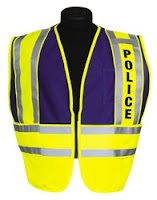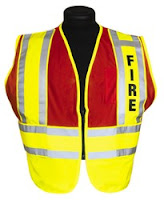High Visibility Safety Vests - Not Just for Roadworkers
- Jun 12, 2013
You're driving down the highway and off to the side of the road you see workers. They might be building a new exit ramp, installing signage or even cleaning up trash along the roadside. One thing that's for sure is they'l be wearing a bright colored high visibility vest or clothing of some sort.
When we see those high visibility vests, often called hi vis vests, we naturally think of construction or road workers. While working on a high rise building or next to speeding traffic, we expect to see workers wearing them because they create awareness, raise visibility and improve safety - it's common sense. However, there are also a lot of other situations where hi vis vests are used on a daily basis for the same reasons. Behind the scenes, hundreds of thousands of workers each day are adorned in bright colored reflective safety apparel that helps them perform their job duties while putting them at a lower risk for accidents and injuries.
At first thought, you might not even be able to name a handful of jobs where hi vis vests and safety gear is used; and since there are so many, we've created a list to help you understand just how important their role is in protecting workers and preventing accidents. While there's too many to list entirely, here's a small sample of the various jobs where they're utilized.
warehouse workers
delivery truck drivers
roadway construction workers
utility workers
surveyors
emergency responders
flaggers
shopping cart retrieversrefinery personnel
messengers
utility workers
loggers
heavy equipment operators
general laborers
fisherman
offshore rig workers
oil workers
firefighters
miners
seamen
divers
ironworkers
railroad workers
emergency response personnel
rescue workers
geologists
policemen
hunters
shipbuilders
salvage workers
foundry workers
crossing guards
racetrack personnel
factory workers
hazardous material handlers
lifeguards
jockeys
security guards
firearms instructors
….and many, many more!
Any place where you can find a hazardous condition, heavy machinery, chemicals, dangerous landscapes, motorists, low-light conditions, extreme weather or moving parts, you can expect to see some sort of high visibility clothing on any workers who are in the area.
High visibility safety vests and apparel help to drastically reduce incidents, accidents and injuries that occur because of large objects, obstructed vision and other similar situations. The list above is only a small sample of occupations where hi vis gear is utilized, yet the uses are practically endless. Whether you're an employer or an employee, high visibility clothing and apparel could play a critical part in the well being of yourself or your business. If your workplace can benefit from mandating the use of high visibility apparel, consider adopting a plan that will be beneficial to everyone. Sit down with your employer, or call a meeting with your employees and discuss the safety benefits that hi vis clothing might be able to offer to individuals and your company.
For more information, product advice or to simply browse our inventory to familiarize yourself with the different types of high visibility safety gear, visit our website today at www.HiVisSupply.com
When we see those high visibility vests, often called hi vis vests, we naturally think of construction or road workers. While working on a high rise building or next to speeding traffic, we expect to see workers wearing them because they create awareness, raise visibility and improve safety - it's common sense. However, there are also a lot of other situations where hi vis vests are used on a daily basis for the same reasons. Behind the scenes, hundreds of thousands of workers each day are adorned in bright colored reflective safety apparel that helps them perform their job duties while putting them at a lower risk for accidents and injuries.
At first thought, you might not even be able to name a handful of jobs where hi vis vests and safety gear is used; and since there are so many, we've created a list to help you understand just how important their role is in protecting workers and preventing accidents. While there's too many to list entirely, here's a small sample of the various jobs where they're utilized.
warehouse workers
delivery truck drivers
roadway construction workers
utility workers
surveyors
emergency responders
flaggers
shopping cart retrieversrefinery personnel
messengers
utility workers
loggers
heavy equipment operators
general laborers
fisherman
offshore rig workers
oil workers
firefighters
miners
seamen
divers
ironworkers
railroad workers
emergency response personnel
rescue workers
geologists
policemen
hunters
shipbuilders
salvage workers
foundry workers
crossing guards
racetrack personnel
factory workers
hazardous material handlers
lifeguards
jockeys
security guards
firearms instructors
….and many, many more!
Any place where you can find a hazardous condition, heavy machinery, chemicals, dangerous landscapes, motorists, low-light conditions, extreme weather or moving parts, you can expect to see some sort of high visibility clothing on any workers who are in the area.
High visibility safety vests and apparel help to drastically reduce incidents, accidents and injuries that occur because of large objects, obstructed vision and other similar situations. The list above is only a small sample of occupations where hi vis gear is utilized, yet the uses are practically endless. Whether you're an employer or an employee, high visibility clothing and apparel could play a critical part in the well being of yourself or your business. If your workplace can benefit from mandating the use of high visibility apparel, consider adopting a plan that will be beneficial to everyone. Sit down with your employer, or call a meeting with your employees and discuss the safety benefits that hi vis clothing might be able to offer to individuals and your company.
For more information, product advice or to simply browse our inventory to familiarize yourself with the different types of high visibility safety gear, visit our website today at www.HiVisSupply.com






 It outlines temporary traffic control measures for lane closures and shifts, detours, shoulder work, median crossovers, mobile operations, and blasting. The MUTCD also addresses topics such as training, personal protective equipment (PPE), speed reduction, barriers, and lighting, as they apply to highway construction. It also provides for uniform design and setup of highway work zones, and includes guidance for the development of temporary traffic control plans (TCPs) that determine the flow of traffic through work zones.
It outlines temporary traffic control measures for lane closures and shifts, detours, shoulder work, median crossovers, mobile operations, and blasting. The MUTCD also addresses topics such as training, personal protective equipment (PPE), speed reduction, barriers, and lighting, as they apply to highway construction. It also provides for uniform design and setup of highway work zones, and includes guidance for the development of temporary traffic control plans (TCPs) that determine the flow of traffic through work zones.







